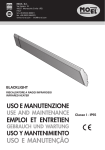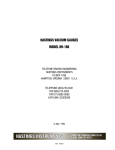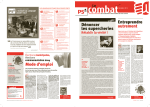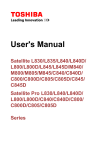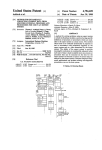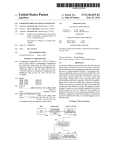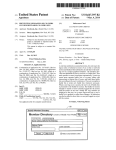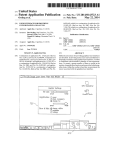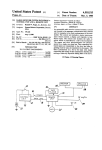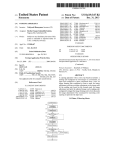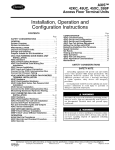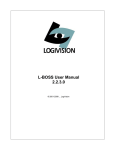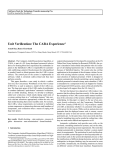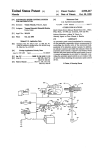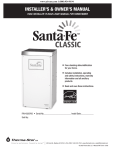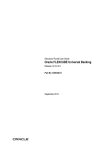Download Heat pump compressor crankcase low differential temperature
Transcript
I United States Patent I19] [11] 4,236,379 Mueller [45] Dec. 2, 1980 ' [54] HEAT PUMP COMPRESSOR CRANKCASE [56] References Cited LOW DIFFERENTIAL TEMPERATURE DETECTION AND CONTROL SYSTEM [75] Inventor: [73] Assignee: U. S . Dale A. Mueller, St. Paul, Minn. PATEN T DOCUMENTS 4,004,431 1/ 1977 Hildreth ............................... .. 62/472 4,136,822 1/1979 Felter ................................ 236/49 Primtuy Examiner—-William E. Wayner Attorney’ Agent’ or Firm_R°ger W' Jensen [57] ABSTRACI‘ A compressor crankcase low differential temperature Honeywell Inc., Minneapolis, Minn. [21] Appl‘ NO‘: 868 _ detection and control system for a reverse-cycle refrig [22] Flledz Jan. 4, 1979 eration system for detecting an abnormally low temper ‘ ature crankcase and for controlling the system in re [51] [52] Int. Cl.3 ...................... .. F04B 49/10; F25B 49/00 US. Cl. ...................................... .. 62/126; 62/193; [58] Field of Search ............... .. 62/193, 211, 127, 126, Sponse to such fault detection by inhibiting the opera tion of the compressor and for providing a fault indica 62/472; 417/32 tiOn. 62/472, 228 R, 229; 417/ 32 I2 K OUTDOOR 2/ ———> / <-—— f 8 Claims, 2 Drawing Figures 20 OUTDOOR AIR (TOMS) REVERSGIG -—-—> VALVE T CONTROL cR?g?EAgE [.43 —AT*I COMPRESSOR CONTROLLER CRANKCASE i i TEMPERATURE "Pr SENSOR / T8’? F42 44 TI-IERRoIIiiiAsTAT FAULT INDICATOR I RESET l7 45 \ 63J A 65/ q / 34 66 (a?- 4 a 4‘E [~54 / 53 ANALOG To Mi I.‘ f‘ 55 DIGITAL CONVERTER ' MICRO PROCESSOR . / 56 52 — Ism) (T035) [J40 MULTIPLEXER i I44 l~-TCC COIL lI 18) I 35 <—r23 ,\~;.-> 1*’ ~32 Z INDOOR Exg?msE i i /7 TODA <— 4— 54 219 TEMSIEENRSAJFIQJRE F /$ ‘25V r3’ —> 52 MEANS EXESAITIGE con. 10 EXPANSION L50 _ US. Patent Dec. 2, 1980' Sheet 1 Of 2 4,236,379 20 Klz 2/ ——>/ OUTDOOR 4-" f 22 EXPANSION MEANS <—- HEAT INDOOR ,6 EXCHANGE COIL <——- 54 ___‘_> REVERSING fTl CONTROL 25 r“ 3/ r IQV il+ T T/a) ‘\ r43 LSTEONOSADGF; ll CRANKCASE ll 1*’ TEMPERATURE "Iv /7 sENsOR (TCCS) /7 LTCC / T872 I THERMOSTAT (STAT) I FAULT INDICATOR J ‘ 45 RESET ‘ / 65 q 63 62 L- 34 r~ 42 44 ROOM CONTROLLER [ 2 I /~/5 COMPRESSOR “32 COIL l CRSQXTCé‘RSE TEMPERATURE EXCHANGE <——/23 fizz-D VALVE /4 HEAT OUTDOOR AIR TODA Flo ———> / 66 47 46 35 \ 54 4 f" 0 ' ) F MULTIPLEXER 53 —> ANALOG TO I 55 f‘ ’ D|G|TAL CONVERTER MICRO PROCESSOR ‘——/— 56 52 | V ~ f \ L50 ‘_l US. Patent Dec. 2, 1980 4,236,379 Sheet 2 0f 2 FIG. 2 LEGEND C) CONNECT TODAS TO A/ D I r404 OPERATION OR INSTRUCTION BLOCK MEASURE TODA LOGIC INSTRUCTION BLOCK DIRECTION OF FLOW CONNECT TCCS TO A/D I [#06 C) MEASURE TCC f- /2/ ENABLE COMPRESSOR OPERATION I r122 TURN OFF FAULT INDICATOR PAUSE IS COMPRESSOR RUNNING ? ENTRY POINT INHIBIT COMPRESSOR OPERATION I [434 TURN ON FAULT INDICATOR JUNCTION 1 4,236,379 HEAT PUMP COMPRESSOR CRANKCASE LOW DIFFERENTIAL TEMPERATURE DETECTION . AND CONTROL SYSTEM BACKGROUND OFTHE INVENTION Heat pumps have been used for many years in the heating and cooling of buildings; their popularity has 2 ing in the crankcase and thus preventing the above described damages to the compressor. Thus, a frequent practice has been, in connection with the installation of ya new heat pump system, to refrain from starting up the compressor for a period of time allowing the crankcase heating means to vaporize any accumulated refrigerant in the crankcase. However, frequently in practice (ei ther through carelessness or ignorance) the heat pump substantially increased in recent times because of the soaring costs of energy used for heating and cooling. installer will energize or turn on the compressor imme Heat pumps become more and more attractive for the val, and hence cause damage to the compressor. Also, a crankcase heater failure will cause every compressor start with potential to dying. Also, an extended heater power loss could cause foaming. function of heating and cooling of buildings because of their operating ef?ciency; ‘i.e., their cost effectiveness. However, heat pumps do have some problems; one of these is connected with the fact that in many systems the refrigerant in the line may, during times that the system is at rest, settle in the crankcase of the compres sor. This is because, in the system “OFF” condition, the refrigerant in the reverse cycle heat pump will tend to condense at the location which has the lowest tempera ture in the system. The “coldest” location typically is in the outdoor unit (where the compressor is usually lo cated) when a system is in the heating mode, because the outdoors is generally much cooler than the indoors for this case. Thus, the refrigerant may settle, i.e., con dense in the crankcase of the compressor; the refriger ant will continue condensing at such coldest location until a point of equilibrium is reached, i.e., an equilib rium of liquid and gaseous refrigerant at the vapor pres sure corresponding to the temperature at such coldest location. It has been recognized heretofore that it is important not to start up the compressor when the re frigerant has settled in the compressor crankcase as it is known that the refrigerant in the crankcase will tend to mix with the compressor lubricating oil therein. It is likely that this mixture is present at equilibrium because the mixture causes a reduction in the total volume of diately; i.e., without waiting for the warming up inter It is an object of our invention to provide a new and effective system for detecting compressor crankcase low differential temperatures and for inhibiting the operation of the heat pump compressor until such time as‘the crankcase temperature increases above the out door air temperature to a safe level. SUMMARY OF THE INVENTION The present invention is a compressor crankcase low differential temperature detection and control system fora reverse cycle refrigeration system comprising the usual refrigerant compression means, including crank case heating means, indoor and outdoor coils, refriger ant conduit means connecting the compression means and the coils, and refrigerant compression control means. In particular, the control system comprises out’ door air temperature sensing means having an output indicative of outdoor air temperature, crankcase tem perature sensing means having an output indicative of the crankcase temperature, enclosure (e.g., building) temperature sensing means having an output indicative of a demand for either heating or cooling of the enclo liquid as compared with a system containing separate pools of oil and refrigerant, thus enabling more refriger‘, sure, fault indicator means, and controller means. The Thereafter, when the compressor is started, if there is outputs thereof. The controller means further has a controller means has operative connections to the three recited temperature sensing means so as to receive the ant to condense at the same equilibrium vapor pressure. 40 refrigerant in the crankcase oil, then such refrigerant will tend to boil due to the low pressure on the suction side of the compressor (where the crankcase is located) and when this happens the refrigerant will agitate the oil causing the oil to foam; this foam then is apt to be carried into the intake of the compressor and thereafter be pumped out by the compressor into the refrigerant lines. When this happens, the oil may be pumped out of the crankcase, thus causing the compressor to run with 50 out lubricant until the oil migrates back having trav elled throughout the complete refrigeration system; i.e., back through the refrigerant tubes and into the crank case. Such running without lubrication may cause se~ vere wear and overheating of the compressor, thus shortening the life of the compressor and causing ex pense, inconvenience and discomfort. Another related problem is that the oil refrigerant foam mixture is not as compressible as refrigerant vapor; this can cause “slug ging” and eventual damage to the valves of the com pressor. . All of the foregoing has heretofore been recognized and various prior art techniques have been proposed for dealing with the problem. Thus, at this time, many heat circuit connect-disconnect means which selectively interconnects the enclosure temperature sensing means to the refrigerant compression control means. The con troller functions so that it is effective to inhibit the com pression means from operating if both the outdoor air temperature is below a predetermined value and if the value of the crankcase temperature minus the outdoor air temperature is greater than a preselected amount. BRIEF DESCRIPTION OF THE DRAWINGS FIG. 1 is a block diagram of a compressor crankcase low temperature detection and control system for a reverse cycle refrigeration system embodying the pres ent invention; and .FIG..2 is a ?ow chart for the control of the apparatus depicted in FIG. 1. DESCRIPTION OF THE PREFERRED EMBODIMENT Referring to FIG. 1, the reverse cycle refrigeration system comprises an indoor heat exchange coil 10, an outdoor heat exchange coil 12, a refrigerant compres sion means or compressor 14, and a compressor control pump compressors have some means for heating the 65 ler 15 receiving energization from an appropriate source 17 of electrical energy. Also associated with the crankcase of the compressor so that the crankcase will compressor 14 is a crankcase heater 19 receiving energi not be the lowest temperature point in the heat pump zation from source 17. Refrigerant conduit means are system; thus preventing the refrigerant from condens 3 4,236,379 provided for interconnecting the coils and the compres sor, the conduit means including the usual reversing valve 16 having a controller 18, an expansion means 20 and appropriate interconnecting piping 21-26. The sys tem above-described is representative of prior art sys 4 indicator 63 and a fault reset means 65, i.e., a switch, both of which will be described in further detail below. For convenience, elements 42, 63 and 65 as above de scribed are shown adjacent to one another in FIG. 1, all having the common designator T872. tems such as that shown in US. Pat No. 3,170,304. As is Further, Honeywell Inc. platinum ?lm resistance well known, such systems function whenever the build ing thermostat is calling for heating or cooling to cause compressor 14 to operate. If heating is being demanded then the compressed hot refrigerant from the compres type temperature sensors models C800A and C800D may be used for TODAS 31 and TCCS 34 respectively. sor 14 will be routed through the reversing valve 16 toward the indoor heat exchange coil 10 where its heat is given up to heat the indoor air. Conversely, if cooling of the building is being demanded, then the hot refriger ant from the compressor is routed through the reversing Also, a‘ Carrier Corporation heat pump comprising outdoor unit model N0. 38CQ033300 and indoor unit model No. 40AQ036300JR may be used for the basic heat pump unit depicted in FIG. 1; i.e., components 10, 12, 14, 15, 16 and 19. ' As indicated above, multiplexer 40 has applied thereto at 32 and 35 analog signals representative of valve to the outdoor heat exchange coil 12 where the refrigerant is cooled for subsequent use indoors to cool TODA and TCC respectively. The function of the the building. input signals in analog form to the output 53 thereof, multiplexer 40 is to supply one or the other of the two depending upon the nature of the control signal being The compressor crankcase low temperature detec tion and control system as depicted in FIG. 1 comprises 20 applied to the multiplexer 40 via a lead 52 from the microprocessor 50; i.e., the microprocessor provides a an outdoor air temperature sensing means 31 (hereinaf control for the multiplexer 40 to select which of the two ter sometimes referred to as “TODAS”) having an input signals is applied to output 53. Output 53 is applied output 32 on which is an output signal indicative of the as the input to a standard analog-to-digital converter 54 outdoor air temperature (hereinafter sometimes re ferred to as “TODA”). TODA on output 32 comprises 25 (herein sometimes referred to as “A/D”) having an output 55 connected as a second input to the micro one of two separate inputs to a multiplexer 40 to be processor 50 and also having an input 56 for receiving described in more detail below. The detection and con controlling instructions from the microprocessor 50. trol system further comprises a crankcase temperature The output from analog-to-digital converter 54 at out sensing means 34 (hereinafter sometimes referred to as put 55 is a signal in digital form indicative of the analog “TCCS”) having an output 35 on which is available an output signal indicative of the crankcase temperature of the compressor, this temperature hereinafter sometimes signal applied to input 53. The microprocessor 50 has an output 62 connected to fault indicator 63. The apparatus being referred to as “TCC”, such TCC signal on 35 further includes the above-mentioned fault reset means 65 having an output 66 which constitutes a third input detection and control system further includes a room 35 to the microprocessor 50. A suitable microprocessor that may be used in the thermostat 42 (hereinafter sometimes referred to as present invention as a component of the system de “STAT”) which responds to the temperature of a room picted in FIG. 1 is the Intel Corporation Model 8049; a or space in a building or the like, the temperature of comprising the second input to multiplexer 40. The suitable representative analog-to-digital converter for which is to be controlled by the reverse cycle refrigera tion system. Room thermostat 42 is depicted as having 40 use to provide the function of block 54 in FIG. 1 is the Texas Instrument Inc. Model TL505C (see TI Bulletin a first output 43 connected to the control 18 for the DLS 12580); and an appropriate multiplexer is the Mo reversing valve 16. A second output 44 of STAT 42 is torola Inc. Model MCl405lBP. connected to a microprocessor 50 and also (through a It will be understood by those skilled in the art that set of contacts 46 and a connection means 45) to the controller 15 of compressor 14. Contacts 46 are con 45 the functional interconnections depicted in FIG. 1 are representative of one or more electrical wires or pipes, tained within a subsection 47 of the microprocessor 50 as the case may be, as dictated by the specific equipment and both 47 and 50 will be described in more detail used. below. A Honeywell Inc. Model T872 heating-cooling ther The detailed operation of the detection and control mostat may be used for the room thermostat 42 depicted 50 system of FIG. 1 may be more speci?cally understood in FIG. 1, the Model T872 being of the bimetal operated mercury switch type including switch means for pro viding the heating-cooling control signals and also for controlling a plurality of auxiliary heating means. As will be understood, whenever STAT 42 calls for either heating or cooling of the controlled space, then a con by reference to the flowchart depicted in FIG. 2 where reference numeral 101 designates an entry point “sys tem power applied” re?ecting the status of the heat pump being powered up; i.e., power 17 being applied to compressor controller 15 and crankcase heater 19 and appropriate energization being applied to any other of the depicted apparatus requiring same. The system then ?ows via junction 102 to instruction block 103 “connect TODAS to A/D”; this being indicative of the TODA via control 18 the reversing valve 16 to the proper orientation for either heating or cooling of the building 60 signal on output 32 being applied via multiplexer 40 to the analog-to-digital (A/D) converter 54. The flow and at 44 to advise microprocessor 50 that heating or from 103 is to operation or instruction block 104 “mea cooling has been called for by STAT 42. The control sure TODA” the flow from which is to instruction signal at 44 is transmitted through the normally closed trol signal is effectively supplied on outputs 43 and 44 thereof, the control signal at 43 functioning to position contacts 46 and connection 45 to control the compres block 105 “connect TCCS to A/D”, the flow from sor 14 from a rest or “off’ condition to an operating or 65 which is to instruction block 106 “measure TCC”. “on” condition and is also applied to microprocessor 50 Thus, instructions 103, 104, 105, and 106 collectively to indicate a demand for compressor 14 operation. The Honeywell Model T872 STAT further includes a fault TCC temperatures, utilizing the aforedescribed multi are associated with the measurement of the TODA and 5 4,236,379 6 s/operations. The ?rst is the inhibiting of the compres sor operation; block 133 is indicative of microprocessor 50 operating to open’ contacts 46 to preventSTAT 42 plexer 40, analog-to-digital converter 54 and micro processor 50. The flow from block 106 is to a logic instruction 107 “TODA>TREF,?” having a yes response 108 and a no response 109. TREF, is a reference temperature or set commanding operationof compressor 14. The second operation resulting'from a'no response 131 is the actua tion of fault indicator163 (by block 134). The closing of the loop by 135 back" to 132 permits the test’ to be re peated; as long as the response from logic instruction point with respect to which TODA is compared; and is selected to be a temperature high enough so that refrig erant would not normally condense in the crankcase or in the outdoor coil; i.e., the refrigerant would stay in 130 continues to be a “no” response at 131,‘ then the gaseous form in the crankcase and in the outdoor coil, and instead the refrigerant would condense in the compressor operation will be inhibited and the fault indicator 63 will be actuated. Knowledgeable personnel notingthat the fault indicator 63 is actuated may take cooler indoor coil. A representative TREE would be 80° F. If TODA is greater than TREE then there is not likely to be a problem with refrigerant mixing with the oil of the compressor crankcase; hence, the yes response 108 ?ows via a junction 120 to an instruction block 121 “enable compressor operation”, the flow from which is to instruction block 122 “turn off fault indicator”, the flow from which is to instruction block 123 “pause”, the flow from which is via a junction 124 to a logic instruc tion block 125 “is compressor running?” having a yes corrective steps, one of which is to permit the passage of enough time to permit the crankcase heater to func tion. In due course the crankcase temperature should increase to the point where the output from 130 will be a yes response 132 to flow through 120 to block 121 et seq so as to successively enable compressor operation and to turn off the fault indicator 63. On the other hand, 20 a persistent fault indication at fault indicator 63 would response 126 and a no response 127. Thus, a yes re necessitate further investigation’ by appropriate servic ing personnel to determine and correct the cause of the fault. sponse at 108 from logic block 107 is representative of As indicated above, an Intel Model 8049 micro an absence of any possible problem and hence is com— patible with normal operation vis: block 121 designates 25 processor may be used to practice the subject invention; as an assistance reference may be made to “INTELR the enabling of compressor operation and 122 is repre MCS-48TM Family of Single Chip Microcomputer sentative of the fault indicator 63 being turned off. The s—User’s Manual”, a 1978 copyrighted manual of the block 123 “pause” is indicative of the periodic recyl Intel Corporation, Santa Clara, California 95051. As a cling of the system, i.e., the periodic functioning of the further assistance, Appendix A hereto and forming a system to determine whether or not there is a problem part hereof, comprises a table of machine readable in with the temperature of the crankcase of the compres struction for controlling the aforesaid Intel Model 8049 sor, a frequency of 120 cycles per hour having been microprocessor for use in the present invention. found satisfactory. Flow from 123 via 124 into logic block 125 “is compressor running?” results in either a While we have described a preferred embodiment of yes or a no response; a yes response 126 ?ows back to 35 our invention, it will be understood that the invention is junction 124 and thence to 125 in a closed loop fashion; however, a no response 127 (indicating that the com pressor is not running) causes flow back to junction 102 so that the test at logic instruction block 107 may be repeated. ~When TODA is not greater than TREE, then the no limited only by the scope of the following claims: I claim: 1. A compressor crankcase low differential tempera ture detection and control system (hereinafter “control system”) for a reverse cycle refrigeration system (here inafter “system”) for heating and cooling an enclosure response 109 from logic instruction 107 causes flow to a wherein said system comprises refrigerant compression logic instruction block 130 “TCC minus TODA is means including crankcase heating means, refrigerant greater than ATMIN?” having a no response 131 and a compression control means, an indoor coil, an outdoor yes response 132. Logic instruction block 130 thus pro 45 coil, and refrigerant conduit means connecting said compression means and said coils, said control system vides a comparison between (i) AT, i.e., the difference comprising: in magnitude between the compressor crankcase tem outdoor air temperature sensing means (hereinafter perature TCC and the outdoor air temperature TODA “TODAS”) having an output indicative of outdoor and (ii) ATMIN where ATMIN is a predetermined value. air temperature (hereinafter “TODA”); If AT is greater than ATMIN, then this is indicative of a 50 safe operating condition, i.e., the crankcase temperature being sufficiently greater than the outdoor air tempera ture so as to con?rm that the crankcase heating means has been operated a suf?cient length of time so as to boil away any refrigerant that otherwise might be comin 55 gled with the oil in the crankcase. Such “safe operating” condition causes a yes response 132 to flow via junction 120 to 121 et seq. A value of ATMIN of 10° F. has been found satisfactory for TODA less than 55° F. and 6° F. for TODA greater than 55° F. However, if the crank 60 case temperature is not high enough, then the no re sponse 131 from 130 will cause flow to an instruction bloc 133 “inhibit compressor operation”, the flow from which is back to junction 10 described above via a con nection 135. Thus, if the crankcase temperature is too 65 low in comparison to the outdoor air temperature, this is indicative of a potential severe problem as described aforesaid; thus, the no response at 131 causes two event compressor crankcase temperature sensing means , (hereinafter “TCCS”) having an output indicative of the temperature (hereinafter “TCC”) of the crankcase of said refrigerant compression means; enclosure temperature sensing means (hereinafter “STAT”) having an output indicative of a demand for heating or cooling of the enclosure; and controller means having operative connections to said TODAS, TCCS, and STAT so as to receive the outputs thereof, said controller means includ ing circuit connect-disconnect means selectively interconnecting said STAT output to said refriger ant compression control means whereby, when said STAT output is connected thereto, said com pression means is enabled to operate in response to a demand from said STAT for heating or cooling and, when said STAT output is disconnected there from, said compression means is inhibited from 7 4,236,379 8 wherein said system comprises refrigerant compression operating, said controller means being effective to inhibit said compression means from operating whenever the value of TCC minus TODA is less than a preselected amount, and said controller means including crankcase heating means, refrigerant compression control means, an indoor coil, an outdoor coil, and refrigerant conduit means connecting said compression means and said coils, said control system means being further characterized by permitting operation of said compression means whenever comprising: TODA is greater than a predetermined value. ‘ outdoor air temperature sensing means (hereinafter 2. Apparatus of claim 1 further characterized by said “TODAS”) having an output indicative of outdoor preselected amount being 10° Fahrenheit when TODA 1 air temperature (hereinafter “TODA”); is less than 55° F. and 6° F. when TODA is greater than 10 55° F. 3. Apparatus of claim 1 further characterized by (i) said control system including fault indicator means and (ii) said fault indicator means being actuated upon, as aforesaid, said controller means inhibiting said compres sion means from operating. 4. Apparatus as described in claim 3 further charac compressor crankcase temperature sensing means (hereinafter “TCCS”) having an output indicative of the temperature (hereinafter “TCC”) of the crankcase of said refrigerant compression means; enclosure temperature sensing means (hereinafter “STAT”) having an output indicative of a demand for heating or cooling of the enclosure; and controller means having operative connections to terized by said controller means permitting operation of said compression means whenever TODA is greater than a predetermined value. 5. Apparatus of claim 1 further characterized by said preselected amount being in the range of 6 to 15 degress Fahrenheit. 6. Apparatus of claim 4 further characterized by said preselected amount being in the range of 6 to 15 degrees 25 Fahrenheit. 7. Apparatus of claim 6 further characterized by said predetermined value being in the range of 80° F.il0° said TODAS, TCCS, and STAT so as to receive the outputs thereof, said controller means includ ing circuit connect-disconnect means selectively interconnecting said STAT output to said refriger ant compression control means whereby, when said STAT output is connected thereto, said com pression means is enabled to operate and, when said STAT output is disconnected therefrom, said com pression means is inhibited from operating, said controller means being effective to inhibit said compression means from operating unless one of the following conditions is satisfied: (1) TODA is above a predetermined value; or (2) the value of TCC minus TODA is greater than F. 8. Compressor crankcase low differential temperature detection and control system (hereinafter “control sys~ tem”) for a reverse cycle refrigeration system (hereinaf ter “system”) for heating and cooling an enclosure a preselected amount. )3 35 45 55 65 * * * Ill








